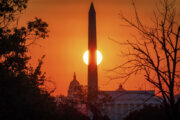Gold prices are up 12 percent this year, with futures markets trading around $1,300 an ounce on the New York Mercantile Exchange. That’s close to the 13 percent gain of the Standard & Poor’s 500 index. Although gold’s values are off the highs set earlier this year, the yellow metal is holding its own. Gold’s near match of the stock market’s performance so far this year is a bit unusual because the precious metal generally does well when investors need a safe haven.
[See: 8 Gold ETFs to Buy Anytime.]
Market watchers say several factors underpin gold prices now — a weaker dollar, tensions with North Korea and the lack of fiscal policy from the White House. Gold dipped following last week’s Federal Open Market Committee meeting where Federal Reserve Chairman Janet Yellen outlined the central bank’s next steps to tighten monetary policy, but most analysts expect gradual interest rate hikes.
Messy politics boost gold indirectly. The biggest influence on gold is the greenback. Gold is denominated in dollars, so the two have an inverse relationship, with the dollar’s recent weakness giving gold its shine. In a research note, Commerzbank attributed some of the dollar’s weakness to U.S. political turmoil, citing special counsel Robert Mueller’s investigation into President Donald Trump’s election team’s contacts with Russia and the lack of any policy decisions so far as a few examples.
The concern is that these disruptions are hampering the administration’s chances of changing the U.S. tax code significantly or ramping up infrastructure spending. “It’s clear after eight months it’s not going to be easy for him to get those policies through,” says Adrian Day of Adrian Day Asset Management in Annapolis, Maryland.
Gold’s recent retreat from this year’s high of about $1,360 an ounce occurred because the dollar rebounded as investors turned their attention to the Fed, Day says. With more Fed rate hikes expected, perhaps one as soon as December and more following in 2018, gold’s shine has dulled somewhat.
Yet Day believes the market’s reaction is overblown. Both Day and Commerzbank point out the Fed tightened interest rates three times since December and gold is up on the year. Furthermore, he says, during an aggressive rate-tightening cycle between 2004 and 2006, when the federal funds rate rose to 5.25 percent from 1.25 percent in 16 separate hikes, gold prices jumped to $700 from $400.
[Read: Overhaul Your Portfolio As Interest Rates Rise.]
Saber-rattling could prompt more investors to run for cover. Gold is often considered a safe asset in times of stress, particularly when global tensions arise. Gold rallied to $1,360 earlier this year thanks to North Korea’s missile tests and saber-rattling between North Korea and the U.S. So far cooler heads prevailed, allowing gold prices to fall, says Daniela Corsini, commodities economist for Italian bank Intesa Sanpaolo Banca IMI, in a research note.
That could be temporary, Corsini says. “Should the diplomatic efforts to reduce the nuclear threat be ineffective or in the event of a further escalation of tensions, gold might gain momentum and trade close to $1,400,” she says. “Conversely, the easing of geopolitical tensions would justify, in the medium term, gold prices between $1,150 and $1,300, depending on the trajectory of the Fed’s monetary policy.”
Not everyone thinks gold will retain this year’s gains. Gold futures trader, Kevin Grady, president of New York-based Phoenix Futures and Options, says the Fed’s plans for raising interest rates and letting matured assets roll off its balance sheets will restrain gold prices. When interest rates rise, gold loses some of its luster for investors because the metal has no yield. In the futures markets, at least, Grady says the buyers who propelled gold to this year’s high are leaving.
Those buyers could return if the war of words between Trump and Kim Jong-un continue. On Monday, gold prices rose following comments by North Korea’s top diplomat that the U.S.’s decision to fly fighter jets and bombers near the demilitarized zone was a “declaration of war.”
“If something catastrophic happens with North Korea, you’re going to see buying off of that,” Grady says.
Prospects usually brighten in the fourth quarter. The calendar may help gold. According to the Commodity Trader’s Almanac, gold prices tend to fall in late summer and then rise toward the end of the year as jewelers and consumers get ready for the holiday shopping season. Because of these common seasonal price swings, Day isn’t concerned about gold’s decline from recent highs.
Corsini expects the demand for physical gold in emerging market countries — particularly China and India, the top-two biggest gold consumers — to support prices in the fourth quarter. Strong seasonal factors and the Fed cautiously implementing monetary policies also could underpin the metal for now, she says. Commerzbank forecasts gold prices will average $1,300 at year-end and rise into 2018, eventually reaching $1,400.
[See: 10 Great Ways to Buy Emerging Markets.]
Gold also may find support from well-known hedge fund managers such as Ray Dalio, chairman of Bridgewater Associates, who recommends taking small positions in gold as a hedge. “I think one of the most important and significant things for gold is that well-known hedge fund managers are talking about it,” prompting more interest from institutional investors, Day says. “Many institutions still underweight gold.”
More from U.S. News
9 Ways to Invest in America With Bond Funds
7 Investment Fees You Might Not Realize You’re Paying
9 Dividend ETFs for Reliable Retirement Income
Gold Prices Shine Even as Stocks Rise originally appeared on usnews.com







